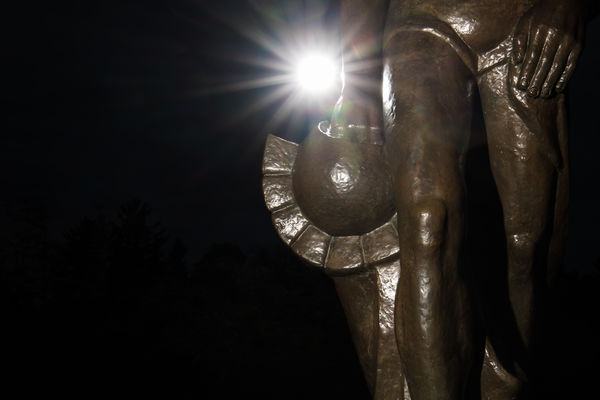Help with kind of flare
Feb 18, 2018 22:43:27 #
Yikes. I was photographing in a church today and pointed my camera down the nave. I was surprised to see the light blobs. Help me understand what happened here?
Thanks . . .
Thanks . . .
Feb 18, 2018 23:19:09 #
LiamRowan wrote:
Yikes. I was photographing in a church today and pointed my camera down the nave. I was surprised to see the light blobs. Help me understand what happened here?
Thanks . . .
Thanks . . .
That facing set of lights is bouncing around (so to speak) and flaring inside your lens. The light blobs are the image of your aperture reflecting off the individual elements in your lens (each surface - front and back!) and back to your sensor. The strong stars are from the direct light source.
***Have someone turn those lights off for you! I bet they are on individual light switches so you can turn just that set off. Most churches would be happy to do that, especially if you give them a print!!.

Feb 18, 2018 23:34:57 #
Feb 19, 2018 00:02:12 #
Whenever you shoot directly into a light source flare is a good possibility. There is really not a whole lot you can do to eliminate it, other than avoid shooting directly into the light. A lens shade may help. a CPL may also help. Flare can enhance a photo. Exposure compensation can also help. The best thing to do, in my opinion. is use it creatively.
Feb 19, 2018 00:19:16 #
LiamRowan wrote:
Yikes. I was photographing in a church today and pointed my camera down the nave. I was surprised to see the light blobs. Help me understand what happened here?
Thanks . . .
Thanks . . .
Hmmm......CrankyCranePhoto.com.......your work? Nice stuff there. ..!
Feb 19, 2018 02:43:35 #
Pablo8
Loc: Nottingham UK.
LiamRowan wrote:
Yikes. I was photographing in a church today and pointed my camera down the nave. I was surprised to see the light blobs. Help me understand what happened here?
Thanks . . .
Thanks . . .
************************************************************
You would have been better off not including those lights in your picture. Surely you could see the flares in the viewfinder while composing the shot? It often happens if a lens hood is NOT used. If you were using a tripod, a simple gesture with the hand shading the lights from the lens, and the flare would have been eliminated. Looks a nice building.
P.S. Just looked at your Profile, and see you have a website. I thought you were a novice beginner from the initial post.
Feb 19, 2018 03:20:06 #
LiamRowan wrote:
Yikes. I was photographing in a church today and pointed my camera down the nave. I was surprised to see the light blobs. Help me understand what happened here?
Thanks . . .
Thanks . . .
If you can re-shoot it, go right ahead, but clean your lens and any filters you may have in the light path. These "blobs" are dust on the front element that are spreading light.
Feb 19, 2018 03:45:16 #
This appears to be a beautiful example of Fraunhofer diffraction.
It is due to the wave nature of light. The effect depends on the wavelength (that is, the colour).
It is most pronounced when bright light from a practically infinite distance passes through narrow slits, causing the light to spread perpendicular to the slits.
This spreads a point-like beam of light into a pair of streaks.
Using a small aperture creates slit-like situations at the corners formed by adjacent blades.
Thus, when you have a combination of relatively intense, point like, monochromatic light sources in the image and a narrow aperture,
you should see a streak (of the same colour) emanating from the points in two directions perpendicular to the blades.
When your diaphragm is formed by straight blades, this will cause there to be twice as many streaks as blades. However, the streaks for parallel blades will coincide. Thus, for a diaphragm with an odd number of blades (where no two blades are parallel) there will be twice as many radial streaks as blades but for a diaphragm with an even number of blades (where opposite blades are parallel) the streaks overlap in pairs, giving the same number of streaks as blades (but each streak is twice as bright).
A classic example is shown in the first image in the Wikipedia article on diffraction, for Fraunhofer diffraction through a square aperture. You see four well-defined streaks.
The theory was published in 1967 by CA Padgham. Ken Rockwell mentions it in his discussion of bokeh.
We should expect a certain amount of diffraction always to be present. It is usually slight and averaged out in most pictures:
it just contributes a tiny amount to the blurriness that is present in any image when looked at closely enough. Only in images that bring together several factors--points of intense monochromatic light, small apertures, straight diaphragm blades--will it become prominent. This information shows how you can make the stars more prominent or how you can suppress them, by altering these factors for your exposure (to the extent you can).
Finally, length of exposure is related to the occurrence of this effect, as you have observed, but only because exposures with bright points of light are almost always made much longer than needed to record the lights: you're trying to see the rest of the scene, which is much darker.
The brightness of the diffraction streaks decreases so rapidly away from their sources that if you used a sufficiently short exposure to properly expose the lights themselves, the streaks would be practically invisible. For instance, there are dimmer but still prominent light sources in your background: they look like windows in the far distance.
They, too, must have their own streaks, but those streaks are too dim to see. (Appropriate software filtering might be able to bring them out.)
It is due to the wave nature of light. The effect depends on the wavelength (that is, the colour).
It is most pronounced when bright light from a practically infinite distance passes through narrow slits, causing the light to spread perpendicular to the slits.
This spreads a point-like beam of light into a pair of streaks.
Using a small aperture creates slit-like situations at the corners formed by adjacent blades.
Thus, when you have a combination of relatively intense, point like, monochromatic light sources in the image and a narrow aperture,
you should see a streak (of the same colour) emanating from the points in two directions perpendicular to the blades.
When your diaphragm is formed by straight blades, this will cause there to be twice as many streaks as blades. However, the streaks for parallel blades will coincide. Thus, for a diaphragm with an odd number of blades (where no two blades are parallel) there will be twice as many radial streaks as blades but for a diaphragm with an even number of blades (where opposite blades are parallel) the streaks overlap in pairs, giving the same number of streaks as blades (but each streak is twice as bright).
A classic example is shown in the first image in the Wikipedia article on diffraction, for Fraunhofer diffraction through a square aperture. You see four well-defined streaks.
The theory was published in 1967 by CA Padgham. Ken Rockwell mentions it in his discussion of bokeh.
We should expect a certain amount of diffraction always to be present. It is usually slight and averaged out in most pictures:
it just contributes a tiny amount to the blurriness that is present in any image when looked at closely enough. Only in images that bring together several factors--points of intense monochromatic light, small apertures, straight diaphragm blades--will it become prominent. This information shows how you can make the stars more prominent or how you can suppress them, by altering these factors for your exposure (to the extent you can).
Finally, length of exposure is related to the occurrence of this effect, as you have observed, but only because exposures with bright points of light are almost always made much longer than needed to record the lights: you're trying to see the rest of the scene, which is much darker.
The brightness of the diffraction streaks decreases so rapidly away from their sources that if you used a sufficiently short exposure to properly expose the lights themselves, the streaks would be practically invisible. For instance, there are dimmer but still prominent light sources in your background: they look like windows in the far distance.
They, too, must have their own streaks, but those streaks are too dim to see. (Appropriate software filtering might be able to bring them out.)
Feb 19, 2018 06:28:14 #
Leicaflex wrote:
This appears to be a beautiful example of Fraunhof... (show quote)
Of course it is, but the OP is not asking about that. He's asking about the random appearance of spots on the image - and a nasty smudge on the right side at the arch. The Fraunhofer diffraction is beautiful, and makes an interesting element in the image. The spots and smudges do not.
Feb 19, 2018 07:55:44 #
yorkiebyte wrote:
Hmmm......CrankyCranePhoto.com.......your work? Nice stuff there. ..!
Yes, thanks!
Feb 19, 2018 08:03:52 #
Pablo8 wrote:
**************************************************... (show quote)
Not a beginner, but wide gaps of knowledge in many areas. I did not see the flares in the viewfinder. I will try the hand trick next time I visit the church (out of town). Thanks.
Feb 19, 2018 08:23:30 #
Leicaflex wrote:
This appears to be a beautiful example of Fraunhof... (show quote)
Thanks, I had not heard of the Fraunhofer diffraction. What was puzzling to me is that I have pointed my camera at light sources many, many times and not had such flare, so was puzzled why it would all of a sudden show up. See this image for example, where the flash is pointed straight at the lens. I suspect your last two paragraphs solve the riddle for me in the case of the church shot--the image is an HDR shot, and the exposure times were 1.6, 3.2, and 6 seconds. So all of them were longer exposures and all showed the affect. Shots like the one below had a fast shutter speed, which apparently avoids the affect.

Feb 19, 2018 08:36:55 #
LiamRowan wrote:
Yikes. I was photographing in a church today and pointed my camera down the nave. I was surprised to see the light blobs. Help me understand what happened here?
Thanks . . .
Thanks . . .
What lens were you using - the iris seems to have many blades!
Feb 19, 2018 08:39:59 #
rehess wrote:
What lens were you using - the iris seems to have many blades!
Canon 16-35mm f4.
Feb 19, 2018 09:41:19 #
Your sample problem photograph is likely the quality of the lens elementsâ coating. The spotlights in the photo are likely 500 watts each and their images are bouncing off all the surfaces inside the lens. I believe the problem is the quality of your lens. There was a thread about why there is difference in the pricing of lens. The optical glass quality and lens coats are a reason why a lens of the same focal length could vary in cost between two hundred to two thousand dollars. The sun is the brightest light source on earth. I have attached a photograph taken with a Nikkor lens that has Nikonâs Nano Crystal Coating. You may see very minimal in lens surface reflections from the bright sun. If you took a photograph looking directly at the sun with a lesser quality lens, I would expect a much greater amount of in lens surface deflections. There are benefits to a better quality (higher priced) lens.
Don, of Menomonee Falls
Don, of Menomonee Falls

If you want to reply, then register here. Registration is free and your account is created instantly, so you can post right away.







